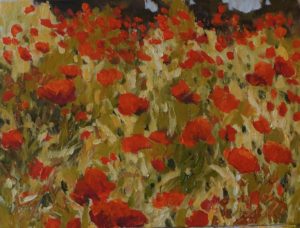A scene in the sitcom “Friends” involves the actor character Joey, speaking about why he cries easily. “I am an Artist. My feelings are always close to the surface.”
Thou the scene is delivered in humour, his character has a point.
Most Artists are sensitive & empathetic.
Therefore, I wasn’t surprised to hear,
“How to paint with peace when the world may feel anything but?”
Short answer: Recognizing it’s even more important to do so motivates the brush.
Reflecting peace despite circumstance is powerful.
Artists, in their connectedness can choose to be a conduit.
Whatever your medium or field of work, leaving a legacy that emulates joy, motivates and reflects peace inspires humanity.
In endurance sport, grit complements training, it doesn’t replace it.
The more we ‘train’, consciously infusing peace daily, our ability to adapt in times of stress increases. Like a muscle, we build our internal ‘peace’ bank.
Simple ways to increase daily peace:
- What can you do to help the situation? Gain knowledge & problem solve? Be of service? offer expertise? contribute? Acting in loving kindness, inspiring people, creating beauty for the world has a ripple effect.
- Discover nature daily. Engaging in Nature improves health & peace of mind. Awaken all your senses, what do you smell, hear, see, feel?
- Have a ‘time out’ from News & electronics. “Connected” 24/7 can be emotionally overwhelming, hard on eyesight & breathing. Heads tipped in continuous ‘i-posture’ cuts off a portion of our air supply.
- Adapt healthy posture & nutrition. Exercise. Practice daily mindfulness, meditation, & deep breathing.
- Create a gratitude list. Write an additional item thru the day, morning, noon, and evening.
- Listen to peaceful music, or watch an inspiring film.“The Canoe” has both. This captivating film (click here https://vimeo.com/199089861 ) by Goh Iromoto beautifully expresses connection to nature thru paddling in a collection of stories. “The Explorers” features Joanie & Gary McGuffin,
I spent a month paddling with the McGuffin’s on expedition in the boreal forest.
Goh captures their passionate sincerity for engaging in and protecting wilderness. Artists in their own right, they wholeheartedly contribute to the health and peacefulness of our planet.
Recognizing peace as a choice is freeing. This act can ignite hope & illuminate possibility. May peace be with you.
~~
Joanie to Dawn in the boreal forest, ”Do you notice when it’s overcast, the lichen glows with light? It’s the only time the lichen shines that special glow.”
 lichen on gray day in boreal~ plein air.
lichen on gray day in boreal~ plein air.
It was an absolute thrill to reunite with the McGuffin ladies this spring, a family that continues to inspire & remain close to my heart.
Joanie & Sila McGuffin.
New Work!
I am excited to share this new work, expressing continuously developing style and colour palette. The new tiny 6×6 inch canvas’s are meant to evoke light, pattern of landscape infused with light. Email me for purchase/ collection details on all work. dawn@dawnbanning.com






























